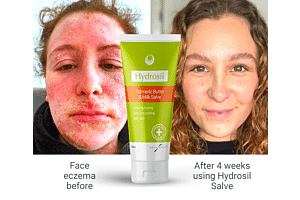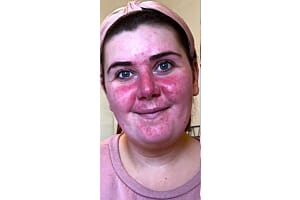A recent study has shed new light on a little-known type of arthritis known as ‘menopausal arthritis’, which effects women at the onset of the menopause and causes moderate to severe pain and swelling mainly in the fingers and wrists.
The study (1), carried out in September 2005, was on women who were taking oestrogen inhibiting drugs for breast cancer, found that the reduction in oestrogen production caused a rapid onset of arthritic symptoms.
The women experienced pain and swelling mainly of the finger and wrist joints, and sometimes in the jaw in a relatively short period following the start of a course of oestrogen blocking hormone therapy.
Until now little has been known about the effects of oestrogen on joint inflammation, but authors of the new study conclude it proves previously held suspicions that a sudden reduction of oestrogen production, such as at the start of the menopause or due to hormone therapy, can trigger a rapid onset of arthritic symptoms.
Evidence suggests that ’menopausal arthritis’ mainly affects the joints in the fingers. It is characterised by bony knobs visible on the fingers. Often small lumps will occur on either side of the joint. Doctors suggest it is not a destructive disease (and can be only temporary) and will respond well to anti -inflammatories both natural and medicinal.
Three ways to prevent menopausal-related Arthritis:
1. Control early aches and pains
Most people would not feel comfortable using regular NSAID’s (Non-Steroidal Anti-Inflammatory Drug) either as a cream or a tablet without having diagnosed and fairly advanced osteoarthritis.
However this study suggests that mild symptoms of bone and joint problems could begin before the menopause takes place. So using a natural non-drug anti-inflammatory cream on any small aches and pains may help delay the onset of menopausal related arthritis through gentle daily management of mild inflammation of the joints.
2. Take supplements to build stronger joints
A recent study found that the two supplements glucosamine and chondroitin sulphate help in preventing the onset of osteoarthritis. The study, carried out at the University of Utah in the US and published by the UK charity Arthritis Research Campaign, found that the two supplements worked best in combination.
The supplements are thought to work as joint cartilage contains both glucosamine and chondroitin and so taking additional supplementation of these two substances helps to build stronger bone cartilage to help guard against arthritis.
The study found the combination of supplements to be effective after several weeks or moderate knee pain caused by early onset osteoarthritis.
3. Eat more selenium
A new study published this week has found that low levels of selenium in people’s diets can increase the risk of osteoarthritis as the mineral acts as a protective antioxidant.
British women are particularly at risk because studies have shown that levels of selenium are very low in British soil compared to the US, meaning that many foods grown in the UK lack beneficial levels of selenium, which may be part of the reason why osteoarthritis is on the rise in the UK.
So incorporating more selenium-rich food sources into your diet in your early 50’s could help reduce women’s risks of getting menopausal-linked arthritis.
Selected food sources of selenium:
|
Food |
Micrograms |
Percent |
| Brazil nuts, dried, unblanched, 1 ounce |
544 |
780 |
| Tuna, light, canned in oil, drained, 3 ounces |
63 |
95 |
| Beef, cooked, 3½ ounces |
35 |
50 |
| Spaghetti w/ meat sauce, 1 serving |
34 |
50 |
| Cod, cooked, 3 ounces |
32 |
45 |
| Turkey, light meat, roasted, 3½ ounces |
32 |
45 |
| Roast beef, lean only, roasted, 3 ounces |
23 |
35 |
| Chicken Breast, meat only, roasted, 3½ ounces |
20 |
30 |
| Noodles, boiled, 1/2 cup |
17 |
25 |
| Macaroni, boiled, 1/2 cup |
15 |
20 |
| Egg, whole, 1 medium |
14 |
20 |
| Cottage cheese, low fat 2%, 1/2 cup |
12 |
15 |
| Oatmeal, instant, fortified, cooked, 1 cup |
12 |
15 |
| Rice, white, long grain, cooked, 1/2 cup |
12 |
15 |
| Rice, brown, long-grained, cooked, 1/2 cup |
10 |
15 |
| Bread, enriched, whole wheat, commercially prepared, 1 slice |
10 |
15 |
| Walnuts, black, dried, 1 ounce |
5 |
8 |
| Bread, enriched, white, commercially prepared, 1 slice |
4 |
6 |
| Cheddar cheese, 1 ounce |
4 |
6 |
Case study:
Pauline Wright, 50, is a telephone customer relations officer from Edinburgh in Scotland with two grown up children.
Pauline says:
"I am currently going through the menopause, although I think I may have had symptoms for a few years before but it wasn’t diagnosed as I was quite young to be starting the menopause."
"My symptoms were typical in that I started getting hot flushes mostly at night, I had some mild mood swings which I really noticed because I’ve never had that sort of thing before and my menstrual cycle became irregular."
[quote]"But one of the symptoms of the menopause I had which actually caused me more pain than anything else was that the joints in my fingers and hands really started to ache and I’d often wake up I the mornings with swollen fingers."[/quote]
"I had started to find it harder to grip things for the first few hours after I woke up for about a year before I went through the menopause, although there was no real pain, just a few minor aches. But it was the loss of action that I noticed first. Even doing up my skirt for work became a bit tricky."
"Before the menopause began, the pain in my fingers was not immense so I didn’t really think to bother my doctor about it, although I did mention it once and he said it was most likely to be a minor sprain as I had it worse in one hand than the other and so that was the hand I showed him."
"But with the onset of the menopause the pain increased and became first annoying, then quite chronic, it was like a nagging ache and the swelling was a problem because it prevented me from doing simple things like opening jars or putting my make up on."
"My mother has arthritis and although she takes medication for it, for the last year she has been using this natural cream called Boswellia and Commiphora joint rub on her hands and knees which she told me helps with the pain and swelling. She suggested I tried some, which I did, and within a week of using it the swelling and pain in my fingers had reduced quite noticeably. After a month I could barely notice it and was able to get my rings back on my fingers, which showed just how much the swelling had gone down. I ordered myself a pot of the cream from the internet for myself and I use it every day twice a day. I find it particularly helpful for the mornings as it brings the overnight swelling down within half an hour."
[quote]"I only wish I had thought to use Boswellia and Commiphora Joint Rub earlier when I first noticed the swelling in my fingers and the lack of movement, and I would not have had to suffer so much pain for the last few years."[/quote]
Pauline used Skin Shop's Boswellia & Commiphora Joint Rub for her menopausal arthritis. Click here for more details
Ref:
(1) Study by David T. Felson, M.D., of Boston University Clinical Epidemiology Unit, and Steven R. Cummings, M.D., of California Pacific Medical Center Research Institute and University of California, San Francisco and published in September 2005 issue of Arthritis & Rheumatism.







